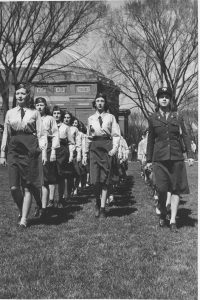This paper is part of the Student Researcher Series which showcases research students have conducted using resources in the Student Life and Culture Archives. If you’re a student who is interested in sharing your research on our blog, please contact us.
Rebecca Purcell is an undergraduate history student at the University of Illinois. This paper was written for History 498:Research and Writing Seminar taught by Professor Leslie Reagan. Rebecca presented her research at the Ethnography of the University Initiative Conference in December 2015.

We often think of women during wartime as someone who the men fighting send letters to. We see them as loved ones, care givers, and providers of those fighting overseas. During World War II women’s roles began to transform into something that did not follow the norms of society set for them in prior wars. Women now had their own divisions of service to sign up for. They had the choice like most men of working under the Airforce, Army, Navy, and the National Guard. Women during World War II played an important role in showing not only how women took on more active roles than they had in previous wars, but also how universities such as U of I became centers where women were able to discover who they wanted to become when it came to war time efforts. These women pushed past restrictions placed on them by men, and proved that they were willing and able to fight for their country just like any man. These women represent not only change, but hope in a future where they could become more than just housewives, but equals to men. Looking at different accounts from the time and prior we can see through their stories and struggles the changes that began to occur after WWII in relation to women. This paper is meant to prove just how significant these women truly were for both the University of Illinois, as well as across the nation making an impact on the U.S., and its military.
During WWI other countries were taking action to ensure that their nations would not crumble when it came to their military strength. They wanted to be prepared for the possibility that their men would all fall in battle. Countries such as Russia, Japan, Germany, England, and many others were preparing for a total war. This preparation began prior to WWI, and grew strong as the war progressed. “For over a decade the women of Germany, Italy, and Japan have been training for war. Their duties range from front line combat to manual labor.”[1] Russia seemed to be the country that allowed women to be involved in more ways than other countries. Russia allowed women to serve as sharpshooters, dig trenches, and carry ammunition on their backs to troops in the line of fire.[2] Countries around the world besides the U.S. at this point allowed women to be involved in military activities. “The British, whose war effort was more nearly total, had already established women’s auxiliaries in several of their services, and there was considerable evidence that had the war lasted a few months longer the United States might have done like wise.”[3] Women’s involvement in the military may have been different in WWII if this would have happened. However, there was one way that women were allowed to be involved in military efforts in WWI. Continue reading “The Stateside Soldiers Abroad and at the University of Illinois”